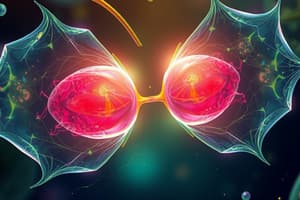Podcast
Questions and Answers
What is the primary purpose of seed dispersal?
What is the primary purpose of seed dispersal?
- To ensure survival and minimize competition (correct)
- To speed up the germination process
- To increase the chance of genetic variation within a plant
- To promote overcrowding in a specific area
Which dispersal method relies on seeds being consumed and passed through an animal's digestive system?
Which dispersal method relies on seeds being consumed and passed through an animal's digestive system?
- Wind Dispersal
- Animal Dispersal (correct)
- Self-dispersal
- Water-dispersal
What characteristic enables seeds to be carried long distances by the wind?
What characteristic enables seeds to be carried long distances by the wind?
- Having a waterproof Testa
- Having a large surface area and being light (correct)
- Being densely packed in fruits
- Being large and heavy
Which of the following statements about dormancy is NOT true?
Which of the following statements about dormancy is NOT true?
What is the role of the waterproof Testa in seed dormancy?
What is the role of the waterproof Testa in seed dormancy?
What is the primary function of the testa in seed structure?
What is the primary function of the testa in seed structure?
How does the food storage differ in monocots and dicots?
How does the food storage differ in monocots and dicots?
What initiates the formation of the seed after fertilization?
What initiates the formation of the seed after fertilization?
Which part of the seed develops into the root of the new plant?
Which part of the seed develops into the root of the new plant?
What is the function of fruit in relation to seeds?
What is the function of fruit in relation to seeds?
In what way can seedless fruits be produced?
In what way can seedless fruits be produced?
What is the characteristic feature of non-endospermic seeds?
What is the characteristic feature of non-endospermic seeds?
What role does the triploid endosperm nucleus play after fertilization?
What role does the triploid endosperm nucleus play after fertilization?
What is a primary requirement for successful seed germination?
What is a primary requirement for successful seed germination?
Which stage occurs first in the process of germination?
Which stage occurs first in the process of germination?
In hypogeal germination, where does the seed remain during growth?
In hypogeal germination, where does the seed remain during growth?
Which method is NOT effective for speeding up seed germination?
Which method is NOT effective for speeding up seed germination?
What role does oxygen play during seed germination?
What role does oxygen play during seed germination?
Which of the following bacterial processes is NOT involved in the germination of seeds?
Which of the following bacterial processes is NOT involved in the germination of seeds?
What type of germination occurs when the seed is carried above the ground?
What type of germination occurs when the seed is carried above the ground?
Which statement accurately describes a characteristic of asexual reproduction in plants?
Which statement accurately describes a characteristic of asexual reproduction in plants?
Flashcards are hidden until you start studying
Study Notes
Double Fertilisation and Seed Formation
- After fertilisation, the ovule swells and the wall toughens, forming the seed coat (testa).
- The zygote develops into the seed embryo, while the triploid endosperm nucleus divides rapidly, creating food storage tissue.
- The ovule transforms into the seed, and integuments thicken to form a protective seed coat.
- Fully formed seeds dry out and enter a dormant state.
Seed Structure
- Embryo: Develops into the new plant.
- Testa: Tough seed coat that protects the seed pre-germination.
- Radicle: The first part to emerge, becoming the root.
- Plumule: Emerges after the radicle, developing into the shoot.
- Cotyledons: Seed leaves containing food reserves; monocots have one, dicots have two. They digest endosperm food for the embryo.
Types of Seeds
- Endospermic Seeds: Found in monocots (e.g., maize, wheat), where food is stored in the endosperm.
- Non-Endospermic Seeds: Present in dicots (e.g., broad bean), with food stored in the cotyledons.
Fruit Formation
- Fruits protect seeds and aid in dispersal.
- Seedless fruits, like watermelons, are cultivated either through genetic selection or enhancing water intake to break seed coats.
- Techniques include soaking seeds to wash out inhibitors and applying plant hormones such as gibberellins.
Germination
- Defined as the growth initiation of the seed or embryo.
Requirements for Germination
- Water: Solvent for transporting materials, enabling hormone and enzyme function.
- Oxygen: Essential for aerobic respiration, providing energy.
- Suitable Temperature: Necessary for enzyme activity.
- Food: Seed reserves must be digested for energy and tissue formation.
Stages in Germination
- Radicle emerges and grows down to form roots.
- Plumule grows upwards, forming shoots, with weight loss during early stages.
- Leaves break through soil, allowing photosynthesis and glucose production for new tissue formation.
- Types of germination:
- Hypogeal: Seed remains below ground during germination.
- Epigeal: Seed is carried above ground.
Asexual Reproduction
- Involves no gametes, leading to genetically identical offspring using plant hormones to induce fruiting without fertilisation.
Seed Dispersal Mechanisms
- Animal Dispersal: Seeds are consumed, passing through an animal’s digestive system, aiding germination (e.g., tomato, apple).
- Wind Dispersal: Seeds must be lightweight with large surface areas to travel far (e.g., sycamore and dandelion).
- Self-Dispersal: Mechanisms like drying pods cause seeds to eject (e.g., gorse).
- Water Dispersal: Seeds buoyed by air pockets can travel over water (e.g., yellow water lily).
Dormancy
- A period of minimal growth/metabolism despite favorable conditions.
Advantages of Dormancy
- Avoids adverse growing conditions that may threaten new growth.
- Extends seed dispersal time, reducing intraspecies competition.
- Allows embryos to mature before conditions improve.
Dormancy in Agriculture and Horticulture
- Dormancy can be maintained by waterproof seed coats (testa), inhibiting water entry.
Studying That Suits You
Use AI to generate personalized quizzes and flashcards to suit your learning preferences.




